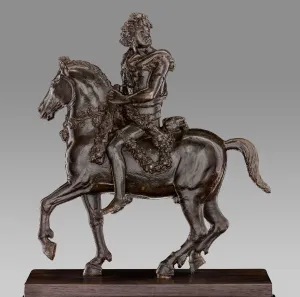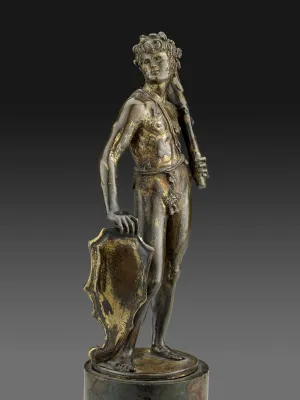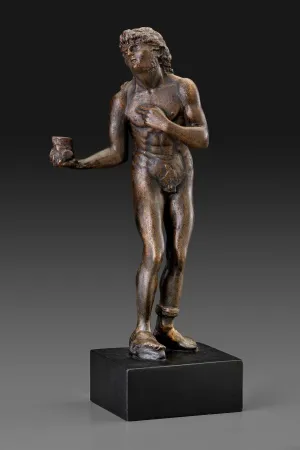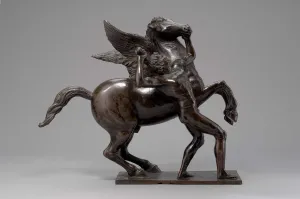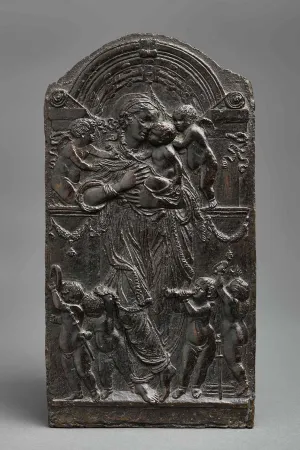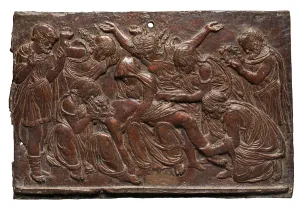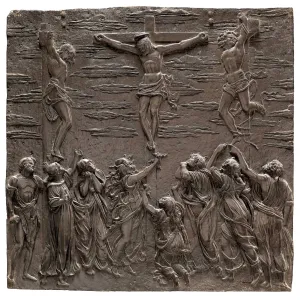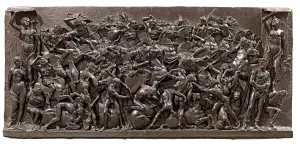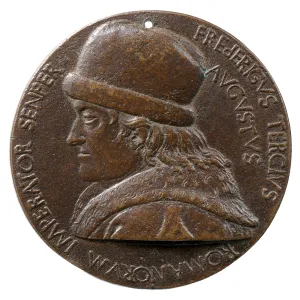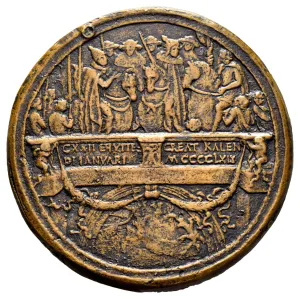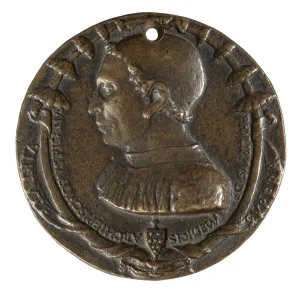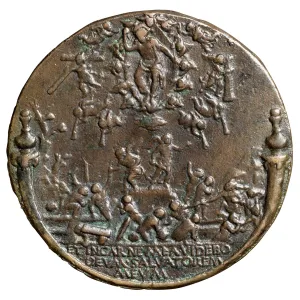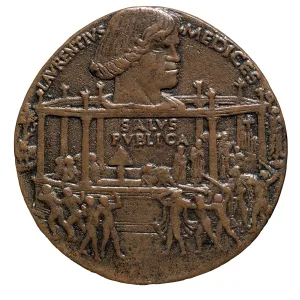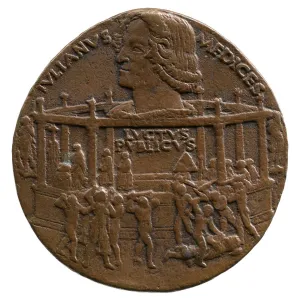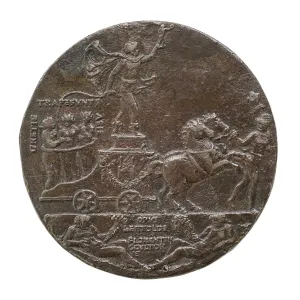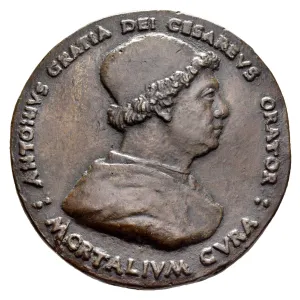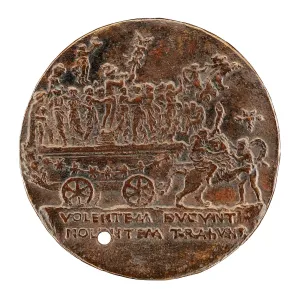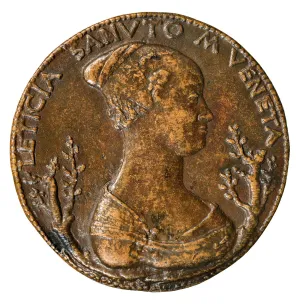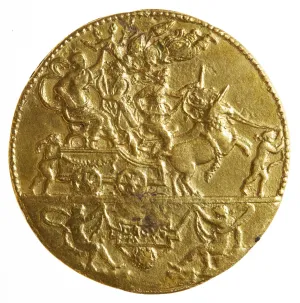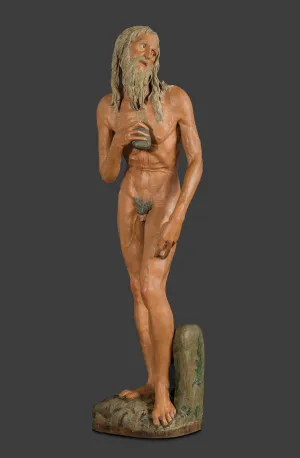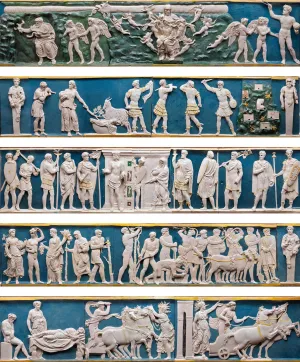All Objects
Bertoldo di Giovanni (ca. 1440–1491)
Orpheus, ca. 1471
Bronze
17 1/8 in. (43.5 cm)
Museo Nazionale del Bargello, Florence (349B)
Ministero per i beni e le attività culturali; photo Mauro Magliani
Bertoldo's largest statuette presumably depicts Orpheus, a mythological figure known for his mastery of the lyre. He plays his instrument as he dances and sings along to his own music, wearing only an animal skin around his shoulders, garland of leaves crowning his head, and half-boots. This statuette has also been identified as Apollo, and the iconography may be intentionally ambiguous, like Bertoldo's Shield Bearers or Battle relief (also included in the exhibition).
Bertoldo di Giovanni (ca. 1440–1491)
Hercules on Horseback, ca. 1470–75
Bronze
10 3/4 in. (27.2 cm)
Gallerie Estensi, Modena (2265)
Ministero per i beni e le attività culturali / Archivio fotografico delle Gallerie Estensi / photo Carlo Vannini
Hercules is here identified by a club (his signature weapon), lion-skin cloak, and muscular appearance. He is large in proportion to his horse, emphasizing his physical strength. One of Hercules's best-known labors was his defeat of the Nemean lion. Here he slips his fingers into the mouth of the leonine trophy that he wears, a reference to illustrations of this episode that show Hercules besting his feline foe by prying apart the beast's jaws.
Bertoldo di Giovanni (ca. 1440–1491)
Shield Bearer, ca. 1470–80
Copper alloy, with extensive traces of gilding
8 13/16 × 3 3/4 × 2 3/4 in. (22.4 × 9.5 × 7 cm)
Henry Clay Frick Bequest (1916.2.03)
© The Frick Collection
See related Shield Bearer
Displayed together for the first time in modern history, Bertoldo's Shield Bearers seem to be mirror images. Both are nude — save for the vines encircling their bodies and the leaves crowning their heads — brandish shields, and wield clubs. They are, however, markedly distinct. The Frick Shield Bearer is younger and suppler, with small horns curling into the tousled locks above his forehead, as well as a swishing tail and set of panpipes that are revealed when the statuette is viewed from behind.
Bertoldo di Giovanni (ca. 1440–1491)
Shield Bearer, ca. 1470–80
Bronze
8 7/8 in. (22.5 cm)
Liechtenstein: The Princely Collections, Vaduz-Vienna (258)
© Liechtenstein. The Princely Collections, Vaduz-Vienna
Displayed together for the first time in modern history, Bertoldo's Shield Bearers seem to be mirror images. Both are nude — save for the vines encircling their bodies and the leaves crowning their heads — brandish shields, and wield clubs. They are, however, markedly distinct. The Frick Shield Bearer is younger and suppler, with small horns curling into the tousled locks above his forehead, as well as a swishing tail and set of panpipes that are revealed when the statuette is viewed from behind.
After Bertoldo di Giovanni (ca. 1440–1491)
Supplicant, 1475–80
Plaster cast (after a bronze original) with paint
9 1/2 × 4 in. (24 × 10 cm)
Made for the Frick by the Gipsformerei, Staatliche Museen zu Berlin, Germany, 2018. Original sculpture: The Pushkin State Museum of Fine Arts, Moscow (3C 197), transferred after World War II; until 1945 Skulpturensammlung, Staatliche Museen, Berlin (2338)
Photo Michael Bodycomb
This cast was produced from a mold made before World War II, when the original bronze was believed to have been destroyed in Berlin. The heavily damaged Supplicant survives in the Pushkin Museum, Moscow, where it was covertly transported in 1946. The subject is unknown. The unidentified object in the right hand may be a sort of vessel. The thick ring around the left ankle may be a shackle. With the gesture of the hand at the chest, the figure acknowledges another presence.
Designed by Bertoldo di Giovanni (ca. 1440–1491), executed by Adriano Fiorentino (ca. 1450/60–1499)
Bellerophon Taming Pegasus, ca. 1480–82
Bronze
12 3/4 in. (32.5 cm)
Kunsthistorisches Museum Vienna, Kunstkammer (KK 5596)
KHM-Museumsverband
The struggle of the hero Bellerophon to tame the winged horse Pegasus was a common subject of ancient texts and artworks, but Bertoldo's depiction was the first since antiquity. Following a classical ode, the sculptor captured the moment at which Bellerophon bends Pegasus to his will using an enchanted bridle. While the bridle is slung over the hero's left shoulder, the sculptor departed from the poem, in which Bellerophon subdues Pegasus by gently placing the charmed reins on the horse, instead transforming the episode into a violent contest between man and beast.
Bertoldo di Giovanni (ca. 1440–1491)
Triumph of Silenus, ca. 1469
Bronze
3 1/2 × 22 3/4 in. (9 × 58 cm)
Museo Nazionale del Bargello, Florence (206B)
Ministero per i beni e le attività culturali; photo Mauro Magliani
A procession of putti dances across this long relief. Clutching bunches of grapes and oversized diamond rings, the youths wear only ostrich-feather headdresses. At the rear, two putti are harnessed to a cart, guided by a panisk (a child with goat legs and tail). Putti on the cart play music for their companions while a man lies prostrate as he is simultaneously poked with a stick and force-fed grapes. The captive is Silenus, Greek god of wine and drunkenness.
Bertoldo di Giovanni (ca. 1440–1491)
Virgin and Child with Angels, ca. 1470
Bronze
10 1/2 × 5 9/16 in. (26.7 × 14.1 cm)
Paris, Musée du Louvre, Département des Objets d'Art (OA 9153)
© RMN-Grand Palais / Stéphane Maréchalle / Art Resource, NY
This plaque is Bertoldo's only surviving depiction of the Virgin and Child. Its function is unknown, though the unfinished edges suggest that it was intended for display within a frame, possibly inset into the cover of a small chest or incorporated into a diptych or triptych. The upper portion of the figural composition — the Virgin and Child flanked by two angels — derives from a gilded bronze tondo by Donatello of about the same scale (ca. 1450; Victoria and Albert Museum, London). For this reason, the plaque may be dated to early in Bertoldo's career.
Designed by Bertoldo di Giovanni (ca. 1440–1491), possibly executed by an associate
Lamentation over the Dead Christ, ca. 1470
Bronze
5 1/2 × 8 1/4 in. (14 × 21 cm)
Museo Nazionale del Bargello, Florence (267B)
Ministero per i beni e le attività culturali; photo Mauro Magliani
This relief is probably an early work as the figures of Christ and female mourners with outstretched arms recall compositions by Donatello. The design is sophisticated, though the execution is less refined than other reliefs by Bertoldo (such as the Crucifixion also included in the exhibition) and therefore may have been cast by an associate. The flanking figures of Nicodemus and Joseph of Arimethea may have been added to Bertoldo's design by another artist, as they are somewhat less elegant than the central group.
Bertoldo di Giovanni (ca. 1440–1491)
Crucifixion, 1470s
Bronze
23 7/8 × 24 1/4 in. (60.5 × 61.5 cm)
Museo Nazionale del Bargello, Florence (207B)
Ministero per i beni e le attività culturali; photo Mauro Magliani
At the moment of his death, Christ slumps forward as his soul leaves his body, hanging crucified between the penitent and impenitent thieves. To his right, the saved thief is lifeless and resigned to his mortality. To his left, the damned thief thrashes against the ties that bind him, one foot and one hand already wrestled free. In drapery, expression, and animation, these figures embody three distinct states from life to death. Below, mourners react in varied ways to the Crucifixion. To the left, St. Jerome, clasping a crucifix and rock, and St.
Bertoldo di Giovanni (ca. 1440–1491)
Battle, ca. 1480–85
Bronze
17 3/4 × 39 1/8 in. (45 × 99.5 cm)
Museo Nazionale del Bargello, Florence (258B)
Ministero per i beni e le attività culturali; photo Mauro Magliani
Bertoldo's largest bronze is an adaptation of an ancient sarcophagus that depicts a battle between Roman soldiers and barbarians. The sarcophagus was severely damaged long before Bertoldo set eyes on it, but he reconstructed the scene of organized chaos by following what was left in the ancient example. However, instead of repeating the narrative of Romans attacking foreigners, clearly identified by their costume in the sarcophagus, here all of the soldiers attack one another without any obvious underlying logic or clear identification.
Bertoldo di Giovanni (ca. 1440–1491)
Emperor Frederick III (1413–93), 1469
Bronze
2 1/4 in. (5.7 cm)
Lent by The Metropolitan Museum of Art, Gift of Assunta Sommella Peluso, Ignazio Peluso, Ada Peluso and Romano I. Peluso, 2010 (2010.417.1)
Inscription: FREdERIGVS TERCIVS / AVGVSTVS ROMANORVM IMPERATOR SENPER [Frederick III, Emperor of the Romans, Perpetual Augustus]
Obverse exhibited| See exhibited reverse
© The Metropolitan Museum of Art / Art Resource, NY
Bertoldo's only dated medal commemorates Holy Roman Emperor Frederick III's visit to Rome to meet with Pope Paul II at the end of 1468. The obverse portrays the likeness of the emperor himself, wearing a fur-trimmed outfit and hat. The reverse depicts an event that took place on New Year's Day, 1469. After attending mass, Frederick proceeded to the bridge in front of Castel Sant'Angelo, where he bestowed a white horse upon the pope and knighted more than one hundred men, crowned a number of poets, and granted doctorates.
Bertoldo di Giovanni (ca. 1440–1491)
Emperor Frederick III (1413–93), 1469
Bronze
2 1/8 in. (5.7 cm)
Staatliche Museen zu Berlin, Münzkabinett (18263093)
Inscription: CXXII EQVITES CREAT KALEN / DI IANVARI MCCCCLXIX [One hundred and twenty-two knights created on the Kalends of January 1469]
Reverse exhibited | See exhibited obverse
Staatliche Museen zu Berlin; photo Karsten Dahmen
Bertoldo's only dated medal commemorates Holy Roman Emperor Frederick III's visit to Rome to meet with Pope Paul II at the end of 1468. The obverse portrays the likeness of the emperor himself, wearing a fur-trimmed outfit and hat. The reverse depicts an event that took place on New Year's Day, 1469. After attending mass, Frederick proceeded to the bridge in front of Castel Sant'Angelo, where he bestowed a white horse upon the pope and knighted more than one hundred men, crowned a number of poets, and granted doctorates.
Bertoldo di Giovanni (ca. 1440–1491)
Filippo de' Medici (1426–74), Archbishop of Pisa, ca. 1470
Bronze
2 1/8 in. (5.7 cm)
Frances Beatty and Allen Adler (A109)
Inscription: PHYLIPPVS DE MEDICIS ARCHIEPISCHOPVS PISANVS [Filippo de' Medici Archbishop of Pisa]
Obverse exhibited | See exhibited reverse
Photo Michael Bodycomb
Filippo de' Medici, Archbishop of Pisa, was a distant relative of Lorenzo de' Medici. This medal, celebrating his piety and position, may have been intended to promote Filippo's aspirations to become a cardinal. Filippo is shown tonsured, facing left, and wearing a rochet. On either side of him is a cord with five tassels, the attributes of an archbishop. The cords are intertwined with a scroll, on which is inscribed Filippo's motto, VIRTVTE SVPERA [By Higher Virtue].
Bertoldo di Giovanni (ca. 1440–1491)
Filippo de' Medici (1426–74), Archbishop of Pisa, ca. 1470
Bronze
2 1/4 in. (5.6 cm)
Museo Nazionale del Bargello, Florence (5959)
Inscription: ET IN CARNE MEA VIDEBO / DEVM SALVATOREM / MEVM [And in my flesh I shall see God my savior]
Reverse exhibited | See exhibited obverse
Ministero per i beni e le attività culturali; photo Mauro Magliani
Filippo de' Medici, Archbishop of Pisa, was a distant relative of Lorenzo de' Medici. This medal, celebrating his piety and position, may have been intended to promote Filippo's aspirations to become a cardinal. Filippo is shown tonsured, facing left, and wearing a rochet. On either side of him is a cord with five tassels, the attributes of an archbishop. The cords are intertwined with a scroll, on which is inscribed Filippo's motto, VIRTVTE SVPERA [By Higher Virtue].
Bertoldo di Giovanni (ca. 1440–1491)
The Pazzi Conspiracy, 1478
Bronze
2 5/8 in. (6.5 cm)
Museo Nazionale del Bargello, Florence (5957)
Inscription: LAVRENTIVS MEDICES / SALVS PVBLICA [Lorenzo de' Medici / public safety]
Obverse exhibited | See exhibited reverse
Ministero per i beni e le attività culturali; photo Mauro Magliani
Unlike any other Renaissance example, the Pazzi Conspiracy medal collapses the traditional obverse and reverse, fusing the portraits, allegorical figures, and historical narrative. The medal commemorates the attempted coup led by the Pazzi family against the Medici brothers in April 1478. Each side shows one brother's bust hovering above a bird's-eye view of the attack in the Florentine cathedral, depicted in a continuous narrative. On Lorenzo's side, a priest leads mass within the octagonal choir.
Bertoldo di Giovanni (ca. 1440–1491)
The Pazzi Conspiracy, 1478
Bronze
2 5/8 in. (6.7 cm)
Stephen K. and Janie Woo Scher Collection; Promised gift to The Frick Collection, New York
Inscription: IVLIANVS MEDICES / LVCTVS PVBLICVS [Giuliano de' Medici / public mourning]
Reverse exhibited | See obverse exhibited
© The Frick Collection
Unlike any other Renaissance example, the Pazzi Conspiracy medal collapses the traditional obverse and reverse, fusing the portraits, allegorical figures, and historical narrative. The medal commemorates the attempted coup led by the Pazzi family against the Medici brothers in April 1478. Each side shows one brother's bust hovering above a bird's-eye view of the attack in the Florentine cathedral, depicted in a continuous narrative. On Lorenzo's side, a priest leads mass within the octagonal choir.
Bertoldo di Giovanni (ca. 1440–1491)
Mehmed II (1433–81), ca. 1480
Bronze
3 3/4 in. (9.4 cm)
Staatliche Museen zu Berlin, Skulpturensammlung und Museum für Byzantinische Kunst (5129)
Inscription: MAVMhET ASIE AC TRAPESVNZIS MAGNE QVE GRETIE IMPERAT. [Mehmed, Emperor of Asia, Trebizond, and Magna Graecia]
Obverse exhibited | See reverse exhibited
Staatliche Museen zu Berlin; photo Karsten Dahmen
This medal, the largest produced by Bertoldo, is the only one signed by the sculptor and was likely commissioned by Lorenzo as a gift for the Sultan Mehmed II in gratitude for Mehmed's extradition of one of the murderers of his brother. Known as "the Conqueror" for toppling the Byzantine Empire, Mehmed was captivated by western art and requested that artists from Florence and Venice be sent to him. As a result, Gentile Bellini produced a medal of the sultan that subsequently became the basis for Bertoldo's own.
Bertoldo di Giovanni (ca. 1440–1491)
Mehmed II (1433–81), ca. 1480
Bronze
3 3/4 in. (9.4 cm)
Gallerie Estensi, Modena (9105)
Inscription: Above the three bound female figures, GRETIE / TRAPESVNTY / ASIE [Greece / Trebizond / Asia]; at bottom, OPVS / bERTOLDI / FLORENTIN / SCVLTOR / IS [The work of Bertoldo Florentine sculptor]
Reverse exhibited | See obverse exhibited
Ministero per i beni e le attività culturali / Archivio fotografico delle Gallerie Estensi / photo Valeria Beltrami
This medal, the largest produced by Bertoldo, is the only one signed by the sculptor and was likely commissioned by Lorenzo as a gift for the Sultan Mehmed II in gratitude for Mehmed's extradition of one of the murderers of his brother. Known as "the Conqueror" for toppling the Byzantine Empire, Mehmed was captivated by western art and requested that artists from Florence and Venice be sent to him. As a result, Gentile Bellini produced a medal of the sultan that subsequently became the basis for Bertoldo's own.
Bertoldo di Giovanni (ca. 1440–1491)
Antonio Graziadei (d. 1492), ca. 1480
Bronze
2 3/8 in. (6 cm)
Staatliche Museen zu Berlin, Münzkabinett (18263094)
Inscription: ANTONIVS GRATIA DEI CAESAREVS ORATOR : MORTALIVM CVRA : [Antonio Graziadei, orator of the emperor : the care of human affairs :]
Obverse exhibited | See exhibited reverse
Staatliche Museen zu Berlin; photo Karsten Dahmen
The Venetian Antonio Graziadei was a Franciscan friar celebrated for his study of astrology, but Bertoldo's medal identifies him as an imperial ambassador, a position he held in Florence in 1480. Graziadei moved in the circles of Holy Roman Emperor Frederick III, whose medal by Bertoldo (also included in the exhibition) perhaps inspired Graziadei to commission his own. The reverse celebrates Graziadei's political role.
Bertoldo di Giovanni (ca. 1440–1491)
Antonio Graziadei (d. 1492), ca. 1480
Bronze
2 1/2 in. (6 cm)
National Gallery of Art, Washington, Samuel H. Kress Collection (1957.14.844)
Inscription: VOLENTEM DVCVNT / NOLENTEM TRAhVNT [They lead the willing and drag the unwilling]
Reverse exhibited | See exhibited obverse
Courtesy National Gallery of Art, Washington
The Venetian Antonio Graziadei was a Franciscan friar celebrated for his study of astrology, but Bertoldo's medal identifies him as an imperial ambassador, a position he held in Florence in 1480. Graziadei moved in the circles of Holy Roman Emperor Frederick III, whose medal by Bertoldo (also included in the exhibition) perhaps inspired Graziadei to commission his own. The reverse celebrates Graziadei's political role.
Bertoldo di Giovanni (ca. 1440–1491)
Letizia Sanudo, ca. 1480
Bronze
3 3/8 in. (8.6 cm)
Bibliothèque Nationale de France, Paris (AV 290)
Inscription: LETICIA SANVTO M VENETA [Letizia Sanudo Venetian Lady]
Obverse exhibited | See exhibited reverse
Bibliothèque Nationale de France
These two specimens are the only known examples of this rare medal that is also Bertoldo's sole depiction of a female sitter. The Venetian lady is seen in a low-cut bodice and flanked by blooming branches. On the reverse, a triumphal scene celebrates her virtue. Two rearing unicorns, fantastical beasts associated with virginity, pull a cart led by a young boy and pushed by a winged putto. Atop the chariot, on the left, is a seated woman with billowing drapery, likely Letizia herself.
Bertoldo di Giovanni (Italian, ca. 1440–1491)
Letizia Sanudo, ca. 1480
Gilt bronze
3 3/8 in. (8.6 cm)
National Museum of Denmark (RP 1442)
Inscription: DECVS / M V [The glory of the women of Venice]
Reverse exhibited | See exhibited obverse
Photo Rasmus Holst Nielsen
These two specimens are the only known examples of this rare medal that is also Bertoldo's sole depiction of a female sitter. The Venetian lady is seen in a low-cut bodice and flanked by blooming branches. On the reverse, a triumphal scene celebrates her virtue. Two rearing unicorns, fantastical beasts associated with virginity, pull a cart led by a young boy and pushed by a winged putto. Atop the chariot, on the left, is a seated woman with billowing drapery, likely Letizia herself.
Probably Donatello (ca. 1386–1466) and Bertoldo di Giovanni (ca. 1440–1491)
St. Jerome, ca. 1465–66
Wood, gesso, and paint
57 7/8 × 13 3/4 × 10 1/4 in. (147 × 35 × 26 cm)
Pinacoteca Comunale, Faenza (168)
Ministero per i beni e le attività culturali, Opificio delle Pietre Dure di Firenze
This sculpture was probably intended for display in an elevated niche, the figure supporting a cross and with a garment covering his genitals. When viewed from below, the blood drawn from beating the stone against his chest would have been more visible. Although the sculpture has been attributed to Donatello since the sixteenth century, scholars beginning in the late nineteenth century have expressed doubts about its authorship. The physical makeup (composed of wood and heavily modeled in gesso) and certain aspects of the sculpture's form are similar to sculptures by Donatello.
Bertoldo di Giovanni (ca. 1440–1491) and collaborators
Frieze for the Portico of Villa Medici at Poggio a Caiano, ca. 1490
Glazed terracotta
Overall: 22 7/8 × 571 1/4 in. (58.1 × 1451 cm)
Villa Medicea di Poggio a Caiano, Polo Museale della Toscana
Gabinetto Fotografico delle Gallerie degli Uffizi


